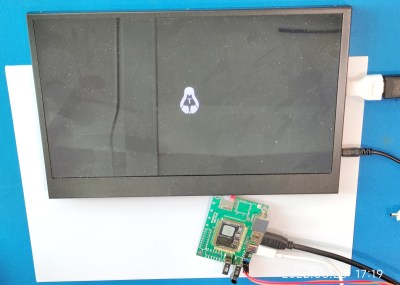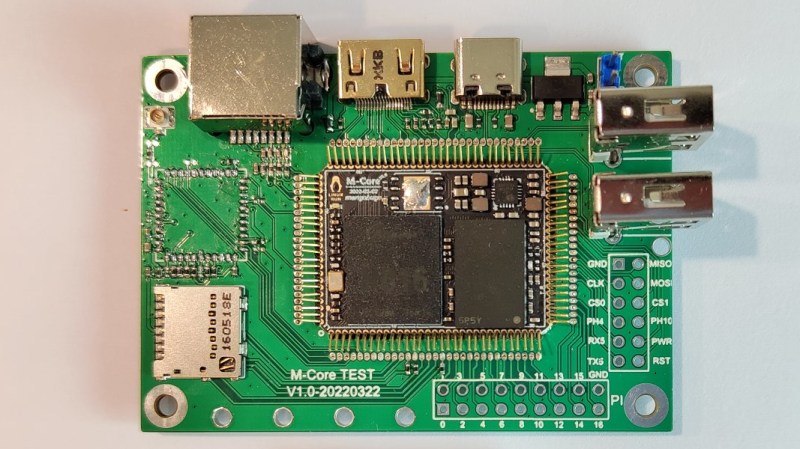Today’s Diminutive Device is a small castellated System-On-Module (Twitter link, nitter proxy) from [MangoPi] called M-Core, with a quad-core A53 CPU and 1 GB of RAM. As such, it’s very capable of running Linux, and even sports an HDMI output! Taking a closer look at the devboard picture, we can spot traces for three USB 2.0 ports, what seems to be two SDIO interfaces for MicroSD or WiFi cards, and an Ethernet MagJack with its termination network. This is a decent set of interfaces, rivaling what we’d expect out of a Pi Zero!
More importantly, this module is as small as an SD card itself – or as an OLED display that we hobbyists sprinkle onto our projects. Having power of Linux in such a small footprint is certainly something to behold! The back of the module is mostly flat, save for a few decoupling capacitors on the other side of the CPU – it seems, an Allwinner H616. On top of it, we can see the CPU itself, a small buck regulator and a DDR3 RAM chip, as well as tightly-packed passives. There’s even an unpopulated footprint for a DFN8 QSPI flash chip – with a lightweight enough OS build, you could perhaps dedicate your MicroSD card to storage only.
 The devboard for uses the “FlexyPins”-like connectivity technique we’ve covered recently, and [MangoPi] say they bought those pins on TaoBao. We can’t help but be a bit amused at the thought of putting HDMI through such connections, but it seems to work well enough! Castellated modules like these are relatively easy to work with, so it shouldn’t be hard to literally pop this module out of the devboard and figuratively pop it onto your PCB. Next step is, reportedly, porting Armbian to this board, likely solving quite a few software support hurdles.
The devboard for uses the “FlexyPins”-like connectivity technique we’ve covered recently, and [MangoPi] say they bought those pins on TaoBao. We can’t help but be a bit amused at the thought of putting HDMI through such connections, but it seems to work well enough! Castellated modules like these are relatively easy to work with, so it shouldn’t be hard to literally pop this module out of the devboard and figuratively pop it onto your PCB. Next step is, reportedly, porting Armbian to this board, likely solving quite a few software support hurdles.
MangoPi have been posting updates on their Twitter page over the last few weeks, and, as it comes with the format, a lot of questions are left unanswered. Why does the devboard only show a single linear regulator of the kind we typically expect to deliver 1 A at most? Will we get higher-RAM versions? What’s the price going to look like? Will this module ever get to market? We can only hope, but if it does indeed, we are sure to see a few projects with these, whether it’s smart glasses, smart displays, phones, handhelds or malicious wall chargers. As usual, community makes or breaks an SBC, and we shall watch this one closely.
We thank [WifiCable] and [DjBiohazard] for sharing this with us!
















Those “FlexyPins” just look wrong when photographed from above, as if things that are supposed to be connected, aren’t!
In an era of surface mount surely they are a pain. Surely it is possible to make a surface mount “FlexyPin”?
The mechanical beauty of the flexy-pin is it uses two drilled bores in the parent PCB for alignment. For an SMD version, you’d both need some kind of large-ish pad to ensure planarity and some way to ensure alignment. I think the only way to do it would be in array, and it would never be as simple/cheap as a bent piece of wire.
Offtopic: Thank You for the Nitter Proxi Link. Twitter is so horrible on a Smartphone.
glad to help ^__^ nitter is a godsend and I’m happy we’ve found a solution that works well for our readers!
Seconded!
+1. nitter works without any javascript, call me impressed! I usually don’t care about Twitter, but sometimes if i need really fresh(?) informations it’s (sadly) the only place to find them, like when there is trouble with public transportations and stuff like this.
The column for the H616 still has many question marks:
https://linux-sunxi.org/Linux_mainlining_effort
Allwinner has been recompiling modified GNU libraries without supplying source code for the D1, so it’s a pretty contentious relationship between them and much of the community that would be involved with mainlining. I’d love for it to happen, though, this would be the perfect candidate for a little programming workbook.
I heard they dropped the D1.
Seconded. Thanks for nitter
Nice, good to have something like this far more flexible than the “we knew it was possible but…” Android USB TV sticks that have been around for near on a decade now.
> Why does the devboard only show a single linear regulator of the kind we typically expect to deliver 1 A at most?
Because the SoC is powered from the X-Powers AXP313A PMIC we see on the module. One can find a picture of its pinout on the website of a Chinese distributor and a driver in the StreamUnlimited Linux Github repository. Since X-Powers doesn’t advertise this chip, I guess it has been designed specifically for the H616.
It is pretty easy to reverse engineer most of the pins of the module using the images of the top and bottom layer from their forum and the Twitter pictures of the devboard. We can e.g. see from the top layer that they didn’t connect PC1, PC7-PC12, PC14-PC16, one of the four USB ports, and the upper 16 bits of the DDR controller. Without PC15/PC16 they missed the opportunity to drive the SPI Flash in QSPI mode. The WIFI/BT footprint on the devboard appears to match the CDW-20U5622-02 module (datasheet in Armbian forum). The pitch of the castellated pins is 0.9mm.
There appears to be a pseudo standard for 44 pin wifi/bt modules and CDW-20U5622-02 is just one example.
Oh this is stellar to know! Thank you so much for sharing.